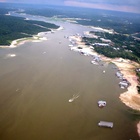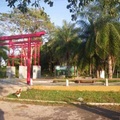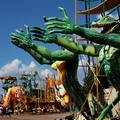There is a tourist spot called Teatro Amazonas in the Centro (downtown) of Manaus. It is an impressive building with pink walls and a mosque-like roof covered with tiles that imitate the Brazilian flag. Every year at Christmas time, a large-scale opera with the participation of local citizens is held on the stage of Teatro Amazonas. On the day, an orchestra plays inside Teatro Amazonas, and local singers sing Christmas songs to the background. Another thing to look forward to is the elaborate performances that are put on every year. In the 2011 performance that I saw, Christ appeared on the roof, angels flew in the sky, performers climbed the walls, and hundreds of fireworks were launched in a spectacular fashion.
In fact, the Amazonas Theater is a building of great historical and cultural value. At the end of the 19th century, Manaus was on the rise with an unprecedented rubber boom and achieved economic growth at a tremendous pace, living up to its name of "a paradise in the jungle." This was long before Japanese immigrants arrived in the Amazon.
Natural rubber from the Amazon was selling so well that everything was overflowing into the city. It was so popular that an opera house was moved from Europe to the city in the jungle. The tiles, windows, and roofing were all brought in by ship. The carefully decorated seats, the ceiling painting depicting the view from directly under the Eiffel Tower, and the furnishings were all simply gorgeous.
In the past, trams ran through the cobblestone city that was home to the opera house, and men came here in search of work, and women in search of money. Later, natural rubber production moved to Southeast Asia, and Manaus suffered a long period of decline. In the 20th century, one of Brazil's leading industrial areas was built, and the city regained its vitality, but...
The Amazonas Theater has seen many historical changes, but today it is often open to the public. I once had the opportunity to stand on stage with the local taiko and yosakoi group Fuuka Kazan at a cultural event introducing Japan. I even got to sing the national anthem here. I also have fond memories of watching a classical guitar orchestra performance featuring fellow musicians and the Amazonas Film Festival, a film festival featuring local artists, here.
"We used to sell a lot of vegetables around here."
Mr. Kiba, Secretary General of the Japan-Brazil Association, told us a story while showing us around the city of Manaus in his private car. Mr. Kiba is originally from Kagoshima, Kyushu, and came to Brazil with his family on the Argentina Maru when he was 10 years old.
"Tsuruta-san, can you see me in this photo?"
While we were waiting at a traffic light, he showed me an old photograph.
"It's this kid!"
"You got it! You got it right!"
The photo, which was apparently taken at the time of departure from Kobe Port, showed the mischievous boy, a head taller than the other children, with a tense expression on his face.
"We were given a lot of different foods on the immigrant ship, but the smell of the dishes bothered me so much that I didn't have much of an appetite."
On November 10, 1958, Kiba and 117 other people from 17 families arrived in the jungle about 40 kilometers from Manaus. Known as the Efegenio Sales settlement, this place was truly an isolated island. The roads were unfinished, and trucks from the Amazonas State Department of Agriculture came back and forth once a week to deliver food and produce to the city. In the jungle, each family cleared the land they were assigned, and planted and grew vegetables.
Under the scorching sun of the tropical jungle, the immigrants struggled with unfamiliar customs and language, as well as tropical diseases, as they prepared their fields, formed unions, considered the education of their children, and established lives as self-sufficient farmers in a foreign country. They all got into trucks and drove along unpaved red dirt roads in the jungle to sell the vegetables grown by the Japanese people in the city.
When I asked him, "So you were selling vegetables in such a famous place?"
"This was quite a difficult task," he told me about what happened at the time.
© 2015 Toshimi Tsuruta








